Exploring Healthcare Policy: Public Health, Obesity, and Sociology
VerifiedAdded on 2023/04/06
|8
|1822
|468
Homework Assignment
AI Summary
This assignment provides comprehensive answers to questions related to healthcare policy and public health. It explores the policy cycle as a tool for developing new policies, differentiates between health and government policy documents, and contrasts the 'new' and 'old' public health approaches. The work also discusses key sociological issues affecting health, the role of power in policy development, and policy considerations for a national obesity health campaign. References are provided to support the analysis and arguments presented. Desklib offers a platform to access this and other solved assignments for students.
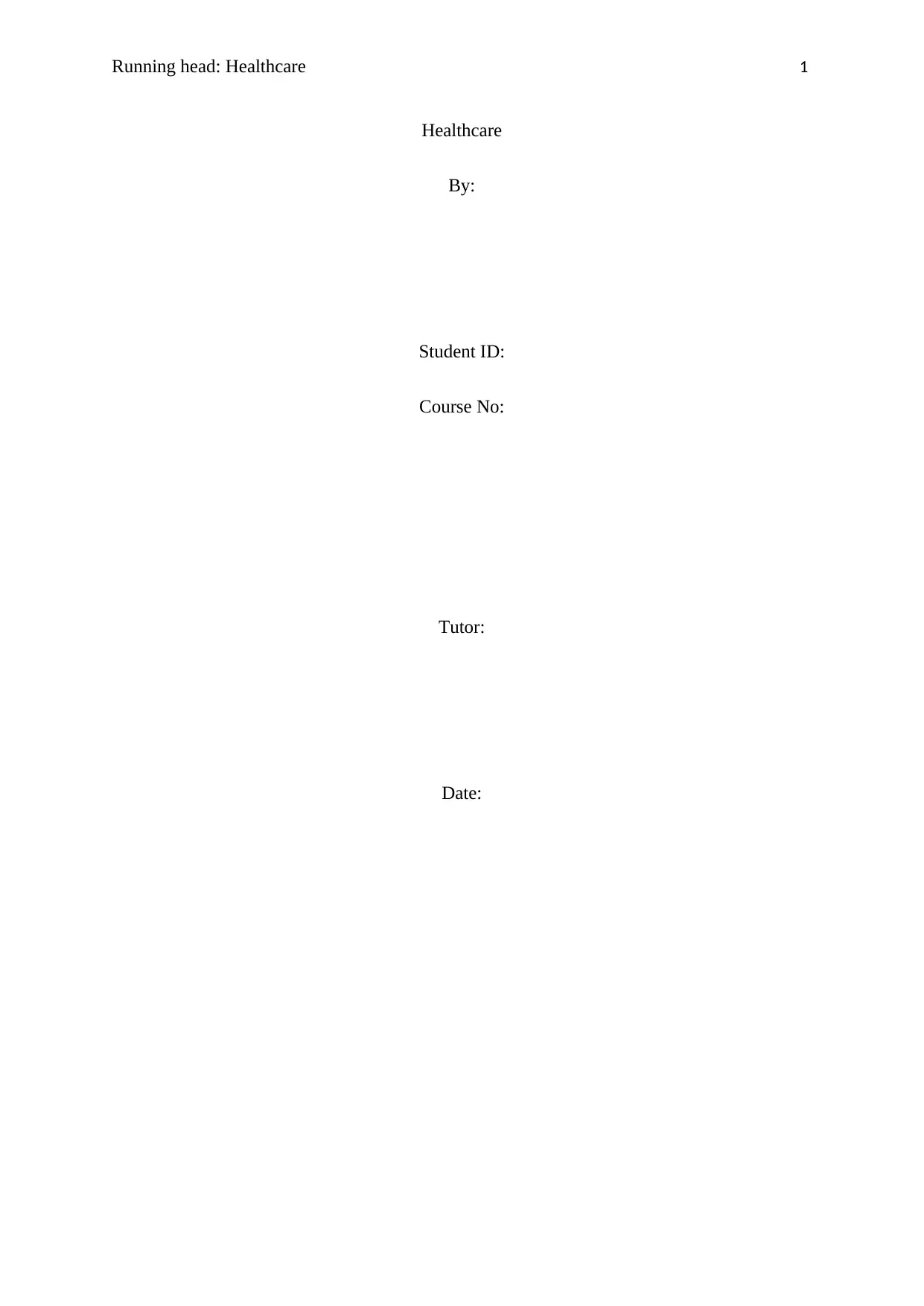
Running head: Healthcare 1
Healthcare
By:
Student ID:
Course No:
Tutor:
Date:
Healthcare
By:
Student ID:
Course No:
Tutor:
Date:
Paraphrase This Document
Need a fresh take? Get an instant paraphrase of this document with our AI Paraphraser
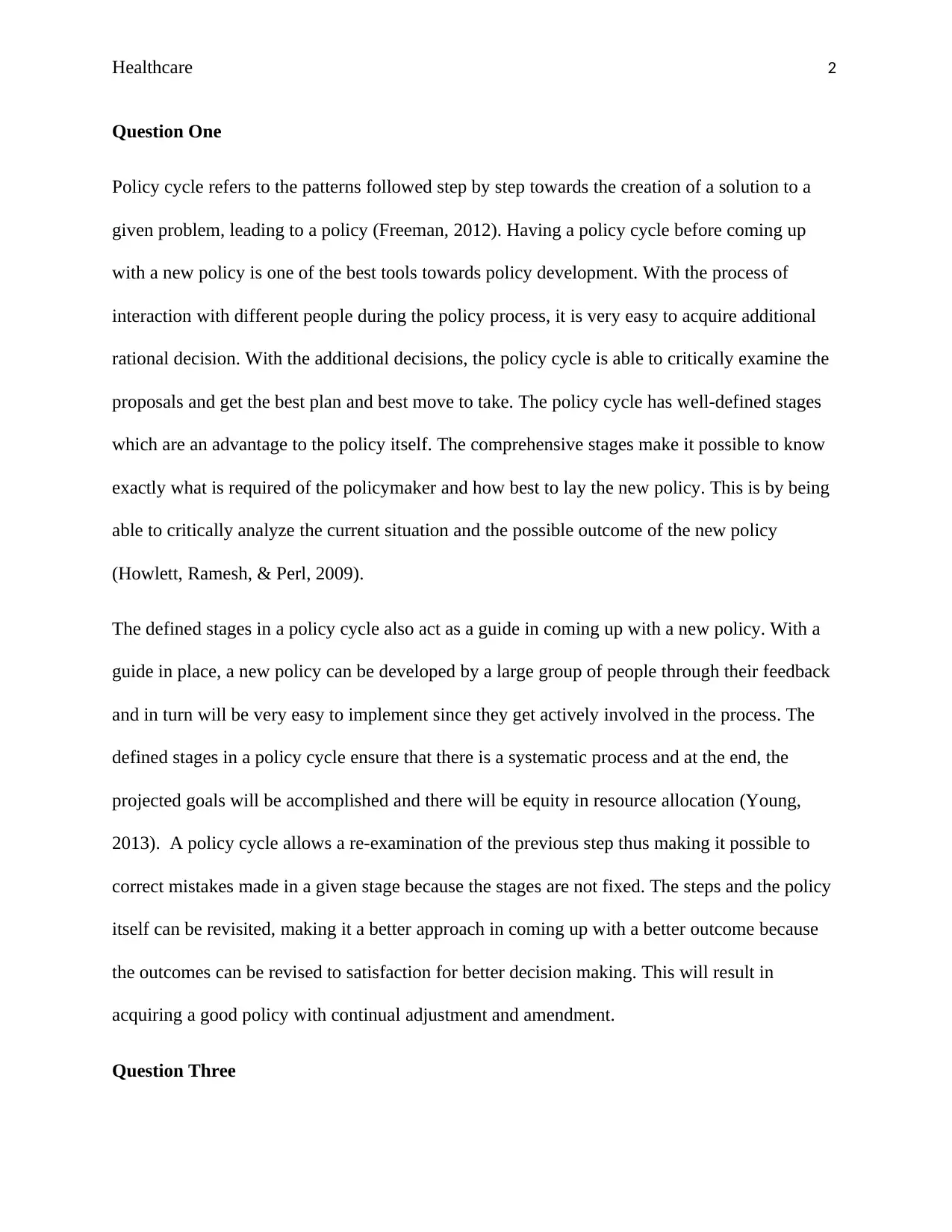
Healthcare 2
Question One
Policy cycle refers to the patterns followed step by step towards the creation of a solution to a
given problem, leading to a policy (Freeman, 2012). Having a policy cycle before coming up
with a new policy is one of the best tools towards policy development. With the process of
interaction with different people during the policy process, it is very easy to acquire additional
rational decision. With the additional decisions, the policy cycle is able to critically examine the
proposals and get the best plan and best move to take. The policy cycle has well-defined stages
which are an advantage to the policy itself. The comprehensive stages make it possible to know
exactly what is required of the policymaker and how best to lay the new policy. This is by being
able to critically analyze the current situation and the possible outcome of the new policy
(Howlett, Ramesh, & Perl, 2009).
The defined stages in a policy cycle also act as a guide in coming up with a new policy. With a
guide in place, a new policy can be developed by a large group of people through their feedback
and in turn will be very easy to implement since they get actively involved in the process. The
defined stages in a policy cycle ensure that there is a systematic process and at the end, the
projected goals will be accomplished and there will be equity in resource allocation (Young,
2013). A policy cycle allows a re-examination of the previous step thus making it possible to
correct mistakes made in a given stage because the stages are not fixed. The steps and the policy
itself can be revisited, making it a better approach in coming up with a better outcome because
the outcomes can be revised to satisfaction for better decision making. This will result in
acquiring a good policy with continual adjustment and amendment.
Question Three
Question One
Policy cycle refers to the patterns followed step by step towards the creation of a solution to a
given problem, leading to a policy (Freeman, 2012). Having a policy cycle before coming up
with a new policy is one of the best tools towards policy development. With the process of
interaction with different people during the policy process, it is very easy to acquire additional
rational decision. With the additional decisions, the policy cycle is able to critically examine the
proposals and get the best plan and best move to take. The policy cycle has well-defined stages
which are an advantage to the policy itself. The comprehensive stages make it possible to know
exactly what is required of the policymaker and how best to lay the new policy. This is by being
able to critically analyze the current situation and the possible outcome of the new policy
(Howlett, Ramesh, & Perl, 2009).
The defined stages in a policy cycle also act as a guide in coming up with a new policy. With a
guide in place, a new policy can be developed by a large group of people through their feedback
and in turn will be very easy to implement since they get actively involved in the process. The
defined stages in a policy cycle ensure that there is a systematic process and at the end, the
projected goals will be accomplished and there will be equity in resource allocation (Young,
2013). A policy cycle allows a re-examination of the previous step thus making it possible to
correct mistakes made in a given stage because the stages are not fixed. The steps and the policy
itself can be revisited, making it a better approach in coming up with a better outcome because
the outcomes can be revised to satisfaction for better decision making. This will result in
acquiring a good policy with continual adjustment and amendment.
Question Three
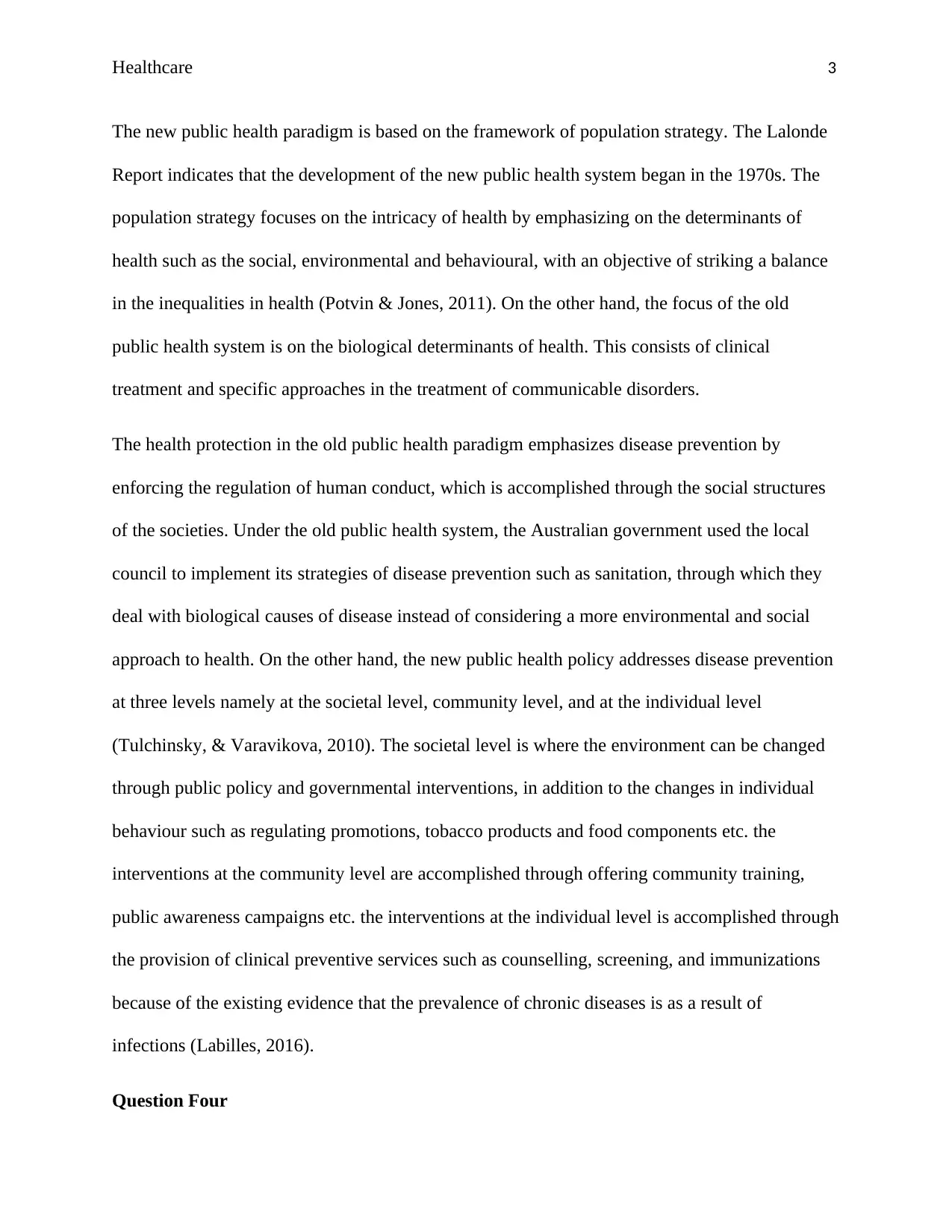
Healthcare 3
The new public health paradigm is based on the framework of population strategy. The Lalonde
Report indicates that the development of the new public health system began in the 1970s. The
population strategy focuses on the intricacy of health by emphasizing on the determinants of
health such as the social, environmental and behavioural, with an objective of striking a balance
in the inequalities in health (Potvin & Jones, 2011). On the other hand, the focus of the old
public health system is on the biological determinants of health. This consists of clinical
treatment and specific approaches in the treatment of communicable disorders.
The health protection in the old public health paradigm emphasizes disease prevention by
enforcing the regulation of human conduct, which is accomplished through the social structures
of the societies. Under the old public health system, the Australian government used the local
council to implement its strategies of disease prevention such as sanitation, through which they
deal with biological causes of disease instead of considering a more environmental and social
approach to health. On the other hand, the new public health policy addresses disease prevention
at three levels namely at the societal level, community level, and at the individual level
(Tulchinsky, & Varavikova, 2010). The societal level is where the environment can be changed
through public policy and governmental interventions, in addition to the changes in individual
behaviour such as regulating promotions, tobacco products and food components etc. the
interventions at the community level are accomplished through offering community training,
public awareness campaigns etc. the interventions at the individual level is accomplished through
the provision of clinical preventive services such as counselling, screening, and immunizations
because of the existing evidence that the prevalence of chronic diseases is as a result of
infections (Labilles, 2016).
Question Four
The new public health paradigm is based on the framework of population strategy. The Lalonde
Report indicates that the development of the new public health system began in the 1970s. The
population strategy focuses on the intricacy of health by emphasizing on the determinants of
health such as the social, environmental and behavioural, with an objective of striking a balance
in the inequalities in health (Potvin & Jones, 2011). On the other hand, the focus of the old
public health system is on the biological determinants of health. This consists of clinical
treatment and specific approaches in the treatment of communicable disorders.
The health protection in the old public health paradigm emphasizes disease prevention by
enforcing the regulation of human conduct, which is accomplished through the social structures
of the societies. Under the old public health system, the Australian government used the local
council to implement its strategies of disease prevention such as sanitation, through which they
deal with biological causes of disease instead of considering a more environmental and social
approach to health. On the other hand, the new public health policy addresses disease prevention
at three levels namely at the societal level, community level, and at the individual level
(Tulchinsky, & Varavikova, 2010). The societal level is where the environment can be changed
through public policy and governmental interventions, in addition to the changes in individual
behaviour such as regulating promotions, tobacco products and food components etc. the
interventions at the community level are accomplished through offering community training,
public awareness campaigns etc. the interventions at the individual level is accomplished through
the provision of clinical preventive services such as counselling, screening, and immunizations
because of the existing evidence that the prevalence of chronic diseases is as a result of
infections (Labilles, 2016).
Question Four
⊘ This is a preview!⊘
Do you want full access?
Subscribe today to unlock all pages.

Trusted by 1+ million students worldwide
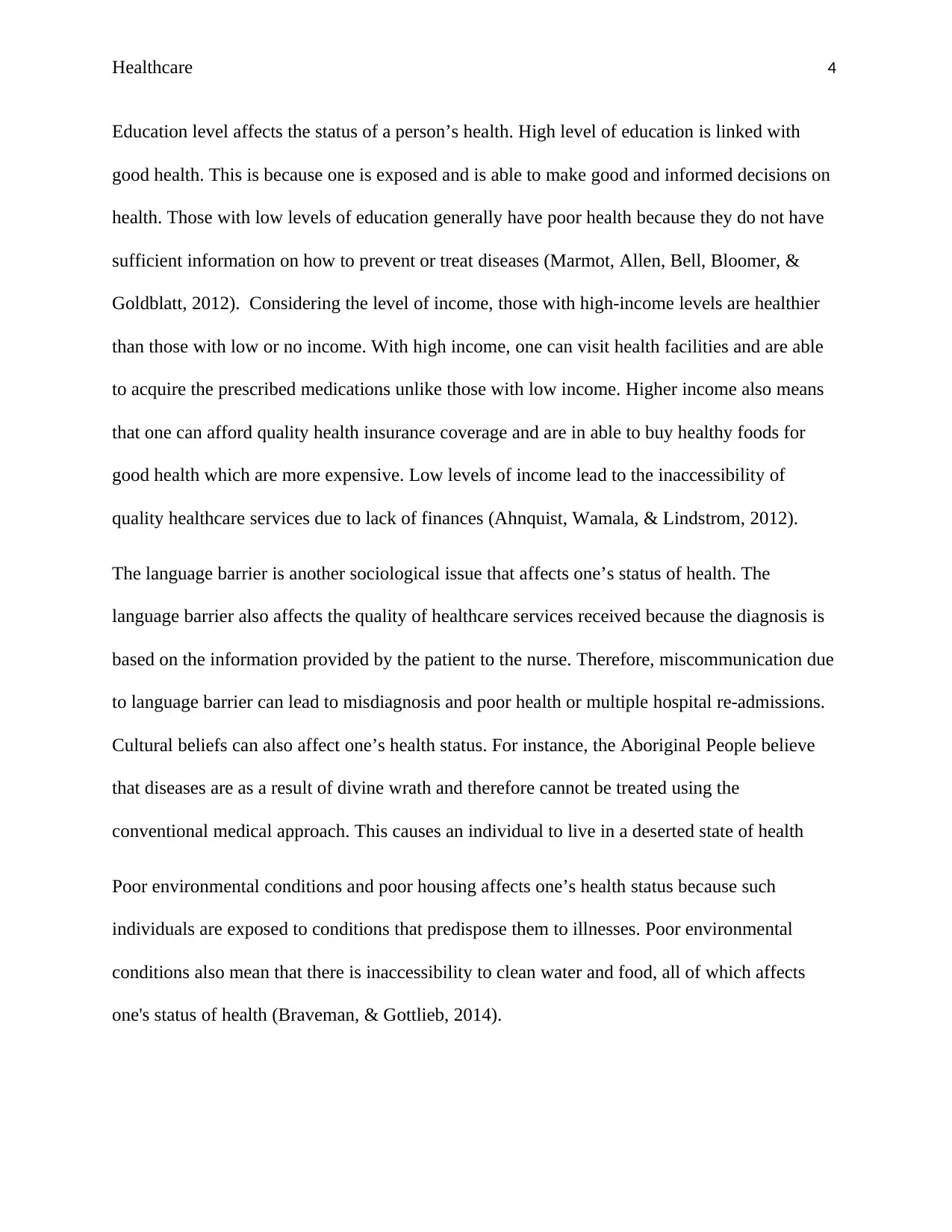
Healthcare 4
Education level affects the status of a person’s health. High level of education is linked with
good health. This is because one is exposed and is able to make good and informed decisions on
health. Those with low levels of education generally have poor health because they do not have
sufficient information on how to prevent or treat diseases (Marmot, Allen, Bell, Bloomer, &
Goldblatt, 2012). Considering the level of income, those with high-income levels are healthier
than those with low or no income. With high income, one can visit health facilities and are able
to acquire the prescribed medications unlike those with low income. Higher income also means
that one can afford quality health insurance coverage and are in able to buy healthy foods for
good health which are more expensive. Low levels of income lead to the inaccessibility of
quality healthcare services due to lack of finances (Ahnquist, Wamala, & Lindstrom, 2012).
The language barrier is another sociological issue that affects one’s status of health. The
language barrier also affects the quality of healthcare services received because the diagnosis is
based on the information provided by the patient to the nurse. Therefore, miscommunication due
to language barrier can lead to misdiagnosis and poor health or multiple hospital re-admissions.
Cultural beliefs can also affect one’s health status. For instance, the Aboriginal People believe
that diseases are as a result of divine wrath and therefore cannot be treated using the
conventional medical approach. This causes an individual to live in a deserted state of health
Poor environmental conditions and poor housing affects one’s health status because such
individuals are exposed to conditions that predispose them to illnesses. Poor environmental
conditions also mean that there is inaccessibility to clean water and food, all of which affects
one's status of health (Braveman, & Gottlieb, 2014).
Education level affects the status of a person’s health. High level of education is linked with
good health. This is because one is exposed and is able to make good and informed decisions on
health. Those with low levels of education generally have poor health because they do not have
sufficient information on how to prevent or treat diseases (Marmot, Allen, Bell, Bloomer, &
Goldblatt, 2012). Considering the level of income, those with high-income levels are healthier
than those with low or no income. With high income, one can visit health facilities and are able
to acquire the prescribed medications unlike those with low income. Higher income also means
that one can afford quality health insurance coverage and are in able to buy healthy foods for
good health which are more expensive. Low levels of income lead to the inaccessibility of
quality healthcare services due to lack of finances (Ahnquist, Wamala, & Lindstrom, 2012).
The language barrier is another sociological issue that affects one’s status of health. The
language barrier also affects the quality of healthcare services received because the diagnosis is
based on the information provided by the patient to the nurse. Therefore, miscommunication due
to language barrier can lead to misdiagnosis and poor health or multiple hospital re-admissions.
Cultural beliefs can also affect one’s health status. For instance, the Aboriginal People believe
that diseases are as a result of divine wrath and therefore cannot be treated using the
conventional medical approach. This causes an individual to live in a deserted state of health
Poor environmental conditions and poor housing affects one’s health status because such
individuals are exposed to conditions that predispose them to illnesses. Poor environmental
conditions also mean that there is inaccessibility to clean water and food, all of which affects
one's status of health (Braveman, & Gottlieb, 2014).
Paraphrase This Document
Need a fresh take? Get an instant paraphrase of this document with our AI Paraphraser
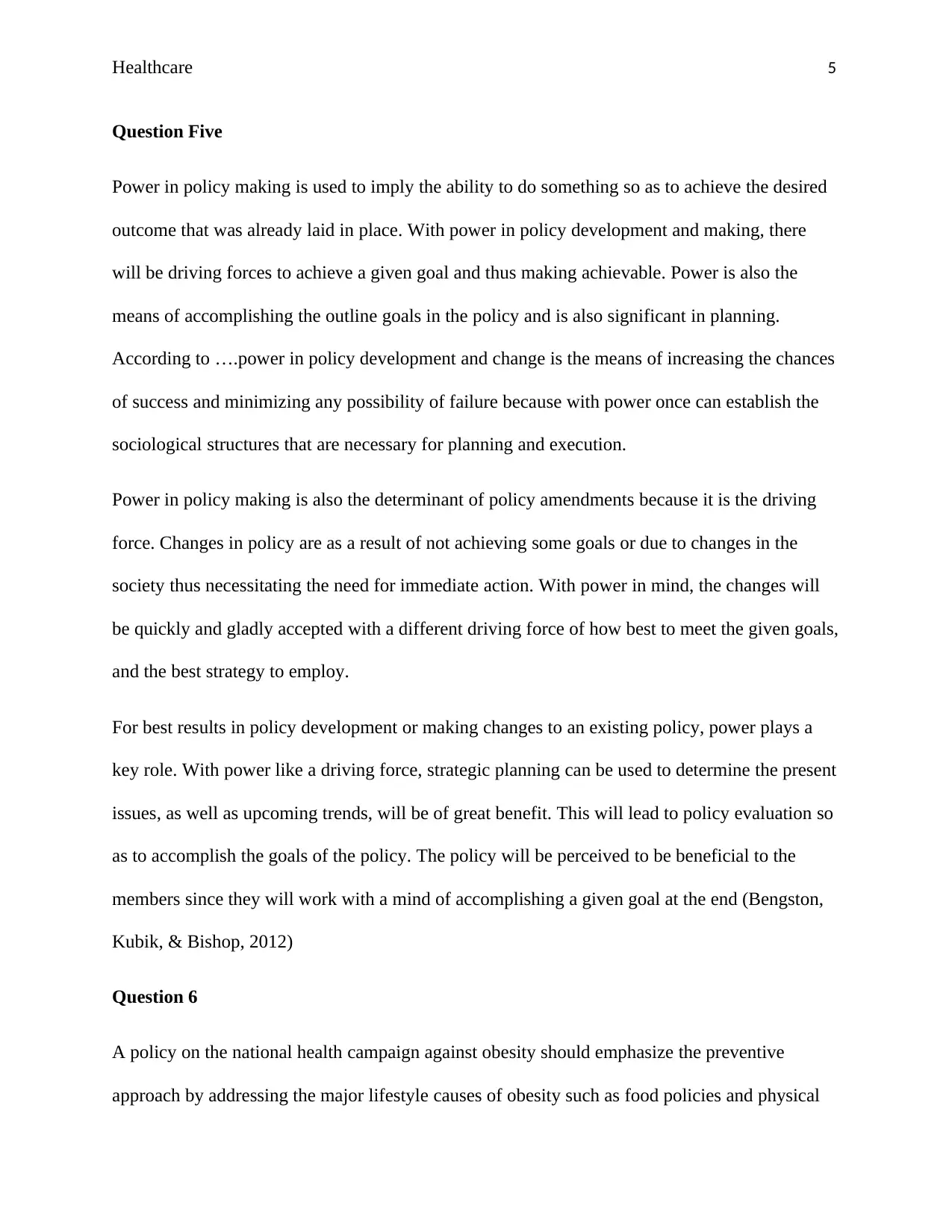
Healthcare 5
Question Five
Power in policy making is used to imply the ability to do something so as to achieve the desired
outcome that was already laid in place. With power in policy development and making, there
will be driving forces to achieve a given goal and thus making achievable. Power is also the
means of accomplishing the outline goals in the policy and is also significant in planning.
According to ….power in policy development and change is the means of increasing the chances
of success and minimizing any possibility of failure because with power once can establish the
sociological structures that are necessary for planning and execution.
Power in policy making is also the determinant of policy amendments because it is the driving
force. Changes in policy are as a result of not achieving some goals or due to changes in the
society thus necessitating the need for immediate action. With power in mind, the changes will
be quickly and gladly accepted with a different driving force of how best to meet the given goals,
and the best strategy to employ.
For best results in policy development or making changes to an existing policy, power plays a
key role. With power like a driving force, strategic planning can be used to determine the present
issues, as well as upcoming trends, will be of great benefit. This will lead to policy evaluation so
as to accomplish the goals of the policy. The policy will be perceived to be beneficial to the
members since they will work with a mind of accomplishing a given goal at the end (Bengston,
Kubik, & Bishop, 2012)
Question 6
A policy on the national health campaign against obesity should emphasize the preventive
approach by addressing the major lifestyle causes of obesity such as food policies and physical
Question Five
Power in policy making is used to imply the ability to do something so as to achieve the desired
outcome that was already laid in place. With power in policy development and making, there
will be driving forces to achieve a given goal and thus making achievable. Power is also the
means of accomplishing the outline goals in the policy and is also significant in planning.
According to ….power in policy development and change is the means of increasing the chances
of success and minimizing any possibility of failure because with power once can establish the
sociological structures that are necessary for planning and execution.
Power in policy making is also the determinant of policy amendments because it is the driving
force. Changes in policy are as a result of not achieving some goals or due to changes in the
society thus necessitating the need for immediate action. With power in mind, the changes will
be quickly and gladly accepted with a different driving force of how best to meet the given goals,
and the best strategy to employ.
For best results in policy development or making changes to an existing policy, power plays a
key role. With power like a driving force, strategic planning can be used to determine the present
issues, as well as upcoming trends, will be of great benefit. This will lead to policy evaluation so
as to accomplish the goals of the policy. The policy will be perceived to be beneficial to the
members since they will work with a mind of accomplishing a given goal at the end (Bengston,
Kubik, & Bishop, 2012)
Question 6
A policy on the national health campaign against obesity should emphasize the preventive
approach by addressing the major lifestyle causes of obesity such as food policies and physical
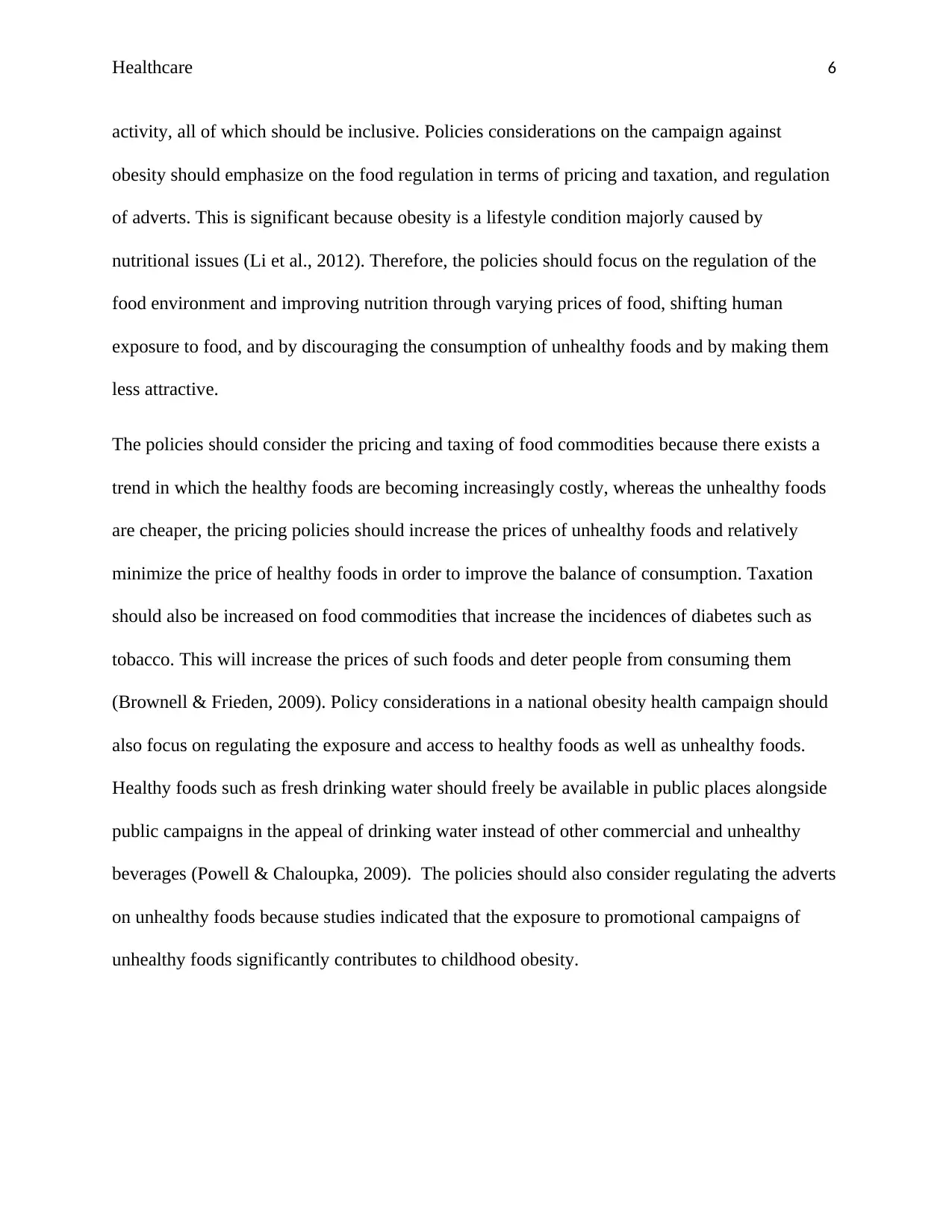
Healthcare 6
activity, all of which should be inclusive. Policies considerations on the campaign against
obesity should emphasize on the food regulation in terms of pricing and taxation, and regulation
of adverts. This is significant because obesity is a lifestyle condition majorly caused by
nutritional issues (Li et al., 2012). Therefore, the policies should focus on the regulation of the
food environment and improving nutrition through varying prices of food, shifting human
exposure to food, and by discouraging the consumption of unhealthy foods and by making them
less attractive.
The policies should consider the pricing and taxing of food commodities because there exists a
trend in which the healthy foods are becoming increasingly costly, whereas the unhealthy foods
are cheaper, the pricing policies should increase the prices of unhealthy foods and relatively
minimize the price of healthy foods in order to improve the balance of consumption. Taxation
should also be increased on food commodities that increase the incidences of diabetes such as
tobacco. This will increase the prices of such foods and deter people from consuming them
(Brownell & Frieden, 2009). Policy considerations in a national obesity health campaign should
also focus on regulating the exposure and access to healthy foods as well as unhealthy foods.
Healthy foods such as fresh drinking water should freely be available in public places alongside
public campaigns in the appeal of drinking water instead of other commercial and unhealthy
beverages (Powell & Chaloupka, 2009). The policies should also consider regulating the adverts
on unhealthy foods because studies indicated that the exposure to promotional campaigns of
unhealthy foods significantly contributes to childhood obesity.
activity, all of which should be inclusive. Policies considerations on the campaign against
obesity should emphasize on the food regulation in terms of pricing and taxation, and regulation
of adverts. This is significant because obesity is a lifestyle condition majorly caused by
nutritional issues (Li et al., 2012). Therefore, the policies should focus on the regulation of the
food environment and improving nutrition through varying prices of food, shifting human
exposure to food, and by discouraging the consumption of unhealthy foods and by making them
less attractive.
The policies should consider the pricing and taxing of food commodities because there exists a
trend in which the healthy foods are becoming increasingly costly, whereas the unhealthy foods
are cheaper, the pricing policies should increase the prices of unhealthy foods and relatively
minimize the price of healthy foods in order to improve the balance of consumption. Taxation
should also be increased on food commodities that increase the incidences of diabetes such as
tobacco. This will increase the prices of such foods and deter people from consuming them
(Brownell & Frieden, 2009). Policy considerations in a national obesity health campaign should
also focus on regulating the exposure and access to healthy foods as well as unhealthy foods.
Healthy foods such as fresh drinking water should freely be available in public places alongside
public campaigns in the appeal of drinking water instead of other commercial and unhealthy
beverages (Powell & Chaloupka, 2009). The policies should also consider regulating the adverts
on unhealthy foods because studies indicated that the exposure to promotional campaigns of
unhealthy foods significantly contributes to childhood obesity.
⊘ This is a preview!⊘
Do you want full access?
Subscribe today to unlock all pages.

Trusted by 1+ million students worldwide
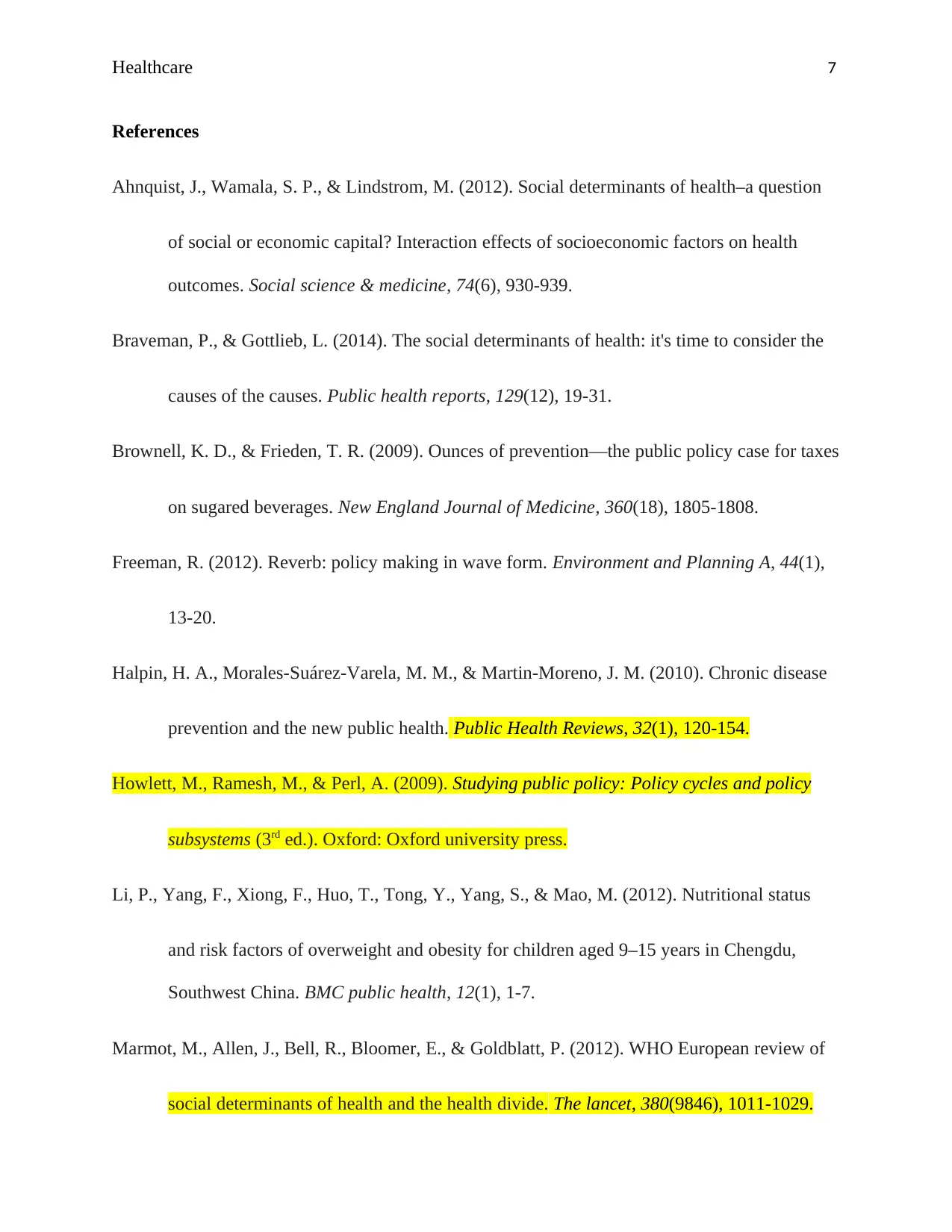
Healthcare 7
References
Ahnquist, J., Wamala, S. P., & Lindstrom, M. (2012). Social determinants of health–a question
of social or economic capital? Interaction effects of socioeconomic factors on health
outcomes. Social science & medicine, 74(6), 930-939.
Braveman, P., & Gottlieb, L. (2014). The social determinants of health: it's time to consider the
causes of the causes. Public health reports, 129(12), 19-31.
Brownell, K. D., & Frieden, T. R. (2009). Ounces of prevention—the public policy case for taxes
on sugared beverages. New England Journal of Medicine, 360(18), 1805-1808.
Freeman, R. (2012). Reverb: policy making in wave form. Environment and Planning A, 44(1),
13-20.
Halpin, H. A., Morales-Suárez-Varela, M. M., & Martin-Moreno, J. M. (2010). Chronic disease
prevention and the new public health. Public Health Reviews, 32(1), 120-154.
Howlett, M., Ramesh, M., & Perl, A. (2009). Studying public policy: Policy cycles and policy
subsystems (3rd ed.). Oxford: Oxford university press.
Li, P., Yang, F., Xiong, F., Huo, T., Tong, Y., Yang, S., & Mao, M. (2012). Nutritional status
and risk factors of overweight and obesity for children aged 9–15 years in Chengdu,
Southwest China. BMC public health, 12(1), 1-7.
Marmot, M., Allen, J., Bell, R., Bloomer, E., & Goldblatt, P. (2012). WHO European review of
social determinants of health and the health divide. The lancet, 380(9846), 1011-1029.
References
Ahnquist, J., Wamala, S. P., & Lindstrom, M. (2012). Social determinants of health–a question
of social or economic capital? Interaction effects of socioeconomic factors on health
outcomes. Social science & medicine, 74(6), 930-939.
Braveman, P., & Gottlieb, L. (2014). The social determinants of health: it's time to consider the
causes of the causes. Public health reports, 129(12), 19-31.
Brownell, K. D., & Frieden, T. R. (2009). Ounces of prevention—the public policy case for taxes
on sugared beverages. New England Journal of Medicine, 360(18), 1805-1808.
Freeman, R. (2012). Reverb: policy making in wave form. Environment and Planning A, 44(1),
13-20.
Halpin, H. A., Morales-Suárez-Varela, M. M., & Martin-Moreno, J. M. (2010). Chronic disease
prevention and the new public health. Public Health Reviews, 32(1), 120-154.
Howlett, M., Ramesh, M., & Perl, A. (2009). Studying public policy: Policy cycles and policy
subsystems (3rd ed.). Oxford: Oxford university press.
Li, P., Yang, F., Xiong, F., Huo, T., Tong, Y., Yang, S., & Mao, M. (2012). Nutritional status
and risk factors of overweight and obesity for children aged 9–15 years in Chengdu,
Southwest China. BMC public health, 12(1), 1-7.
Marmot, M., Allen, J., Bell, R., Bloomer, E., & Goldblatt, P. (2012). WHO European review of
social determinants of health and the health divide. The lancet, 380(9846), 1011-1029.
Paraphrase This Document
Need a fresh take? Get an instant paraphrase of this document with our AI Paraphraser
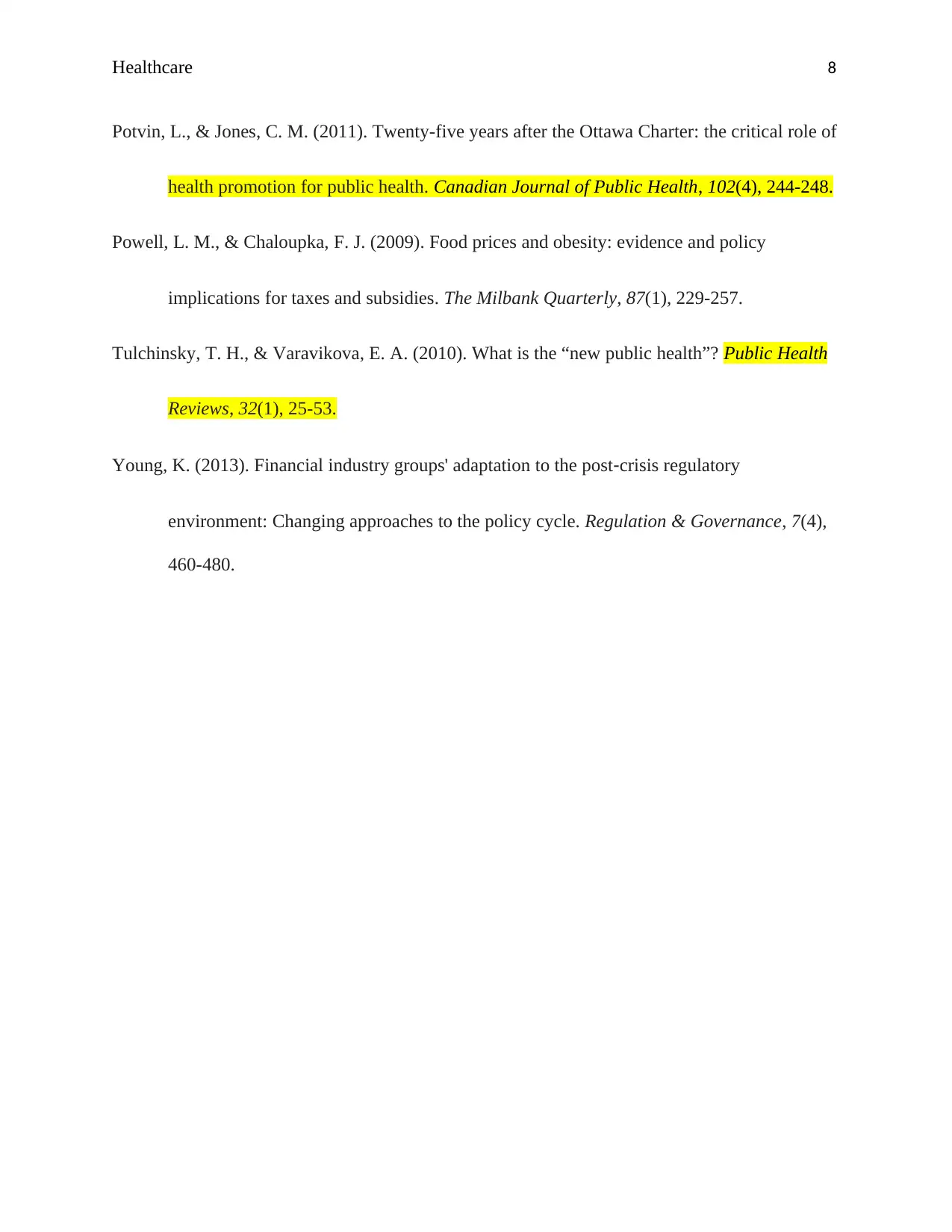
Healthcare 8
Potvin, L., & Jones, C. M. (2011). Twenty-five years after the Ottawa Charter: the critical role of
health promotion for public health. Canadian Journal of Public Health, 102(4), 244-248.
Powell, L. M., & Chaloupka, F. J. (2009). Food prices and obesity: evidence and policy
implications for taxes and subsidies. The Milbank Quarterly, 87(1), 229-257.
Tulchinsky, T. H., & Varavikova, E. A. (2010). What is the “new public health”? Public Health
Reviews, 32(1), 25-53.
Young, K. (2013). Financial industry groups' adaptation to the post‐crisis regulatory
environment: Changing approaches to the policy cycle. Regulation & Governance, 7(4),
460-480.
Potvin, L., & Jones, C. M. (2011). Twenty-five years after the Ottawa Charter: the critical role of
health promotion for public health. Canadian Journal of Public Health, 102(4), 244-248.
Powell, L. M., & Chaloupka, F. J. (2009). Food prices and obesity: evidence and policy
implications for taxes and subsidies. The Milbank Quarterly, 87(1), 229-257.
Tulchinsky, T. H., & Varavikova, E. A. (2010). What is the “new public health”? Public Health
Reviews, 32(1), 25-53.
Young, K. (2013). Financial industry groups' adaptation to the post‐crisis regulatory
environment: Changing approaches to the policy cycle. Regulation & Governance, 7(4),
460-480.
1 out of 8
Related Documents
Your All-in-One AI-Powered Toolkit for Academic Success.
+13062052269
info@desklib.com
Available 24*7 on WhatsApp / Email
![[object Object]](/_next/static/media/star-bottom.7253800d.svg)
Unlock your academic potential
Copyright © 2020–2025 A2Z Services. All Rights Reserved. Developed and managed by ZUCOL.




